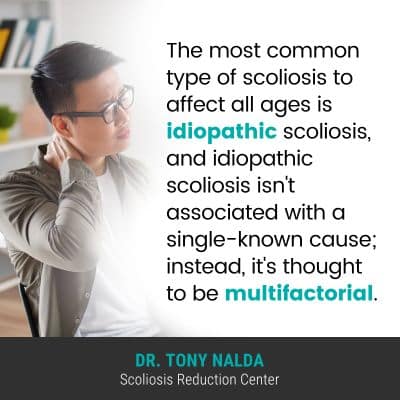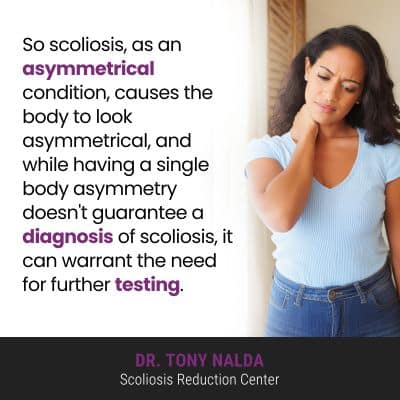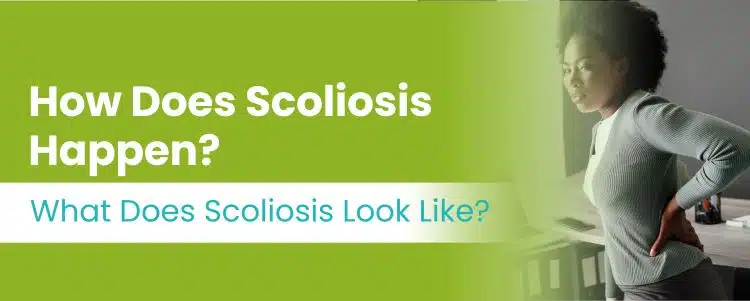Scoliosis involves progression, and how this happens is through growth. We don’t always know what causes scoliosis to develop initially, but we know it’s growth that triggers it to get worse, and as this happens, the effects of scoliosis become more overt and noticeable.
Scoliosis happens for different reasons, depending on the condition type in question. Most cases of scoliosis have no known cause, but there are atypical types associated with known causes. Scoliosis affects the body in different ways, including disrupting its overall symmetry.
Let’s start with the different types of scoliosis and why they develop, and then let’s shift the focus to what scoliosis looks like (postural changes).
Types of Scoliosis
One of the reasons scoliosis treatment plans need to be customized is because scoliosis ranges so widely in severity, and there are also different types of scoliosis a person can develop.
Scoliosis ranges in severity from mild scoliosis to moderate scoliosis, severe and very severe scoliosis, and condition severity is determined by a measurement known as Cobb angle.
A patient’s Cobb angle is determined during X-ray and tells me how far out of alignment a patient’s spine is and shapes the customization of treatment plans.
The complex nature of scoliosis necessitates the customization of treatment options, and plans are based on key patient/condition variables: patient age, condition severity, type, and curvature location.

The most common type of scoliosis to affect all ages is idiopathic scoliosis, and idiopathic scoliosis isn’t associated with a single-known cause; instead, it’s thought to be multifactorial.
Idiopathic Scoliosis
Conditions that are multifactorial develop because of a number of variables, or a combination of certain variables, that can change from one patient to the next.
Idiopathic scoliosis isn’t genetic, but it is familial, meaning if there is a family history of scoliosis, there is more likely to be another diagnosis, but a specific gene, or genetic combination, has yet to be identified that accounts for the development of idiopathic scoliosis.
Families share a lot more than just their genes; they share socioeconomic factors, body types, lifestyles, diet, responses to stress, and even posture.
So scoliosis is more likely to happen if another family member has been diagnosed and can seem to run in families.
Considering the multifactorial nature of scoliosis, a number of factors, some of which are familial, could contribute to scoliosis developing.
While we don’t fully understand why idiopathic scoliosis develops initially, we do understand that it’s growth that makes it progress, and this is why childhood scoliosis should always be taken seriously; the more growth a patient has yet to go through, the more potential progression they can be facing.
In fact, in the condition’s most-prevalent type, adolescent idiopathic scoliosis, diagnosed between the ages of 10 and 18, because of the rapid and unpredictable growth spurts associated with puberty, this age group is the most at risk for rapid-phase progression.
And what causes scoliosis diagnosed with known causes?
Scoliosis Diagnosed with Known Causes
Approximately 80 percent of known cases are considered idiopathic, and the remaining 20 percent are associated with known causes: neuromuscular scoliosis, congenital scoliosis, and degenerative scoliosis.
These cases are considered atypical and have unique treatment needs; in typical cases of idiopathic scoliosis, the curve bends to the right, away from the heart, but in atypical types, curves can bend to the left, towards the heart.
When I see left-bending curves on an X-ray, this is a red flag that the scoliosis developed because of an underlying pathology.
Neuromuscular Scoliosis
Neuromuscular scoliosis, for example, develops as a secondary complication of a larger neuromuscular condition like muscular dystrophy, spina bifida, or cerebral palsy.
Neuromuscular conditions cause a disconnect between the brain and the muscles and/or connective tissues that support the spine, causing the development of an unnatural side to side curve of the spine that also twists.
Neuromuscular scoliosis patients are among the most difficult to treat because the larger neuromuscular condition has to be the focus of treatment.
Not everyone with a neuromuscular condition will develop scoliosis, but it is a common complication.
Congenital Scoliosis
Congenital scoliosis is a rare form, affecting approximately 1 in 10,000 babies; this type happens because the spine is malformed in utero, so babies are born with the condition.
Spinal malformations can involve vertebral bodies failing to separate and develop into distinct bones, or one or more vertebrae being more triangular in shape, making it difficult to stay aligned and develop healthy spinal curves.
Degenerative Scoliosis
Degenerative scoliosis is caused by natural age-related spinal degeneration so commonly affects older adults (50+), and the cumulative effect of certain lifestyle factors can shape a person’s rate and level of spinal degeneration.
In most cases of spinal degeneration, it starts with the intervertebral discs deteriorating.
So scoliosis happens for different reasons, depending on type, but what does the condition actually look like? Is it always obvious to others if someone has scoliosis?
How Scoliosis Affects The Body
Scoliosis is a spinal condition, but it doesn’t just affect the spine and its surroundings, but also the entire body, and no two cases of scoliosis are the same and will require the same treatment plan.
In childhood scoliosis, the most noticeable effect that brings patients in for a diagnosis and treatment are postural changes caused by how the condition’s uneven forces disrupt the body’s overall symmetry.
As a child grows, the condition is likely to get worse, meaning its effects are going to become more noticeable and overt.
In many cases of child and adolescent idiopathic scoliosis, uneven shoulders and hips are the earliest signs of scoliosis.
Additional changes to the body can include:
- Uneven shoulder blades
- Development of a rib cage arch
- An uneven waist
- Arms and legs hanging at different lengths

In addition to the visual postural changes that scoliosis can cause, the condition causes disruptions to a person’s coordination, balance, and gait.
So scoliosis, as an asymmetrical condition, causes the body to look asymmetrical, and while having a single body asymmetry doesn’t guarantee a diagnosis of scoliosis, it can warrant the need for further testing.
In order to reach a diagnosis of scoliosis, an unnatural sideways-bending and twisting spinal curve with a minimum Cobb angle measurement of 10 degrees is required, requiring a scoliosis X-ray to see what’s truly happening in and around the spine.
How Does Scoliosis Happen in Adults?
Although more common in children, scoliosis also affects adults; in fact, the actual rate of scoliosis increases with age.
The two main types of scoliosis affecting adults are idiopathic scoliosis and degenerative scoliosis, and cases of idiopathic scoliosis happen to adults who have been living with scoliosis unaware since adolescence.
As scoliosis doesn’t become compressive until adulthood, it’s not often painful for adolescents, and when mild, scoliosis isn’t associated with functional deficits, so it’s a common scenario that adults don’t know they have scoliosis until their conditions have become compressive and painful.
Growing spines are experiencing a constant lengthening motion that counteracts the compressive force of the unnatural spinal curve.
Scoliosis pain relief is a focus of adult scoliosis treatment and is the number-one reason adults come in to see me for a late diagnosis of idiopathic scoliosis, and the unfortunate reality is that had they received a diagnosis and treatment during adolescence, their spines would be in far better shape than by the time they come to see me.
Adults also experience postural changes, noticeably a prominent lean to one side that’s most visible when bending forward, but pain is the main effect that brings them in for a diagnosis and treatment.
Adult scoliosis pain can involve back pain, muscle weakness and pain, and radiating pain due to nerve compression.
Scoliosis is also known to cause a muscular imbalance, which can be painful, as the unnaturally-curved spine pulls its surrounding muscles in different directions, causing the muscles on one side of the spine to become stretched from overuse, while the muscles on the opposite side can become weak from underuse.
Conclusion
So how does scoliosis happen? Different types of scoliosis develop for different reasons. Idiopathic scoliosis is multifactorial, while neuromuscular scoliosis develops as a related complication of a larger neuromuscular condition.
Congenital scoliosis happens to babies born with the condition due to a malformed spine that develops in utero, and degenerative scoliosis develops due to spinal degeneration and lifestyle factors.
Carrying excess weight, leading a sedentary lifestyle, excessive consumption of alcohol and/or smoking, chronic poor posture, and repeatedly lifting heavy objects incorrectly are factors that can shape a patient’s long-term spinal health.
While we don’t always know what causes idiopathic scoliosis to happen initially, we do know what causes it to progress: growth.
It’s important for patients to understand that as a progressive condition, what a patient’s scoliosis looks like at the time of diagnosis doesn’t mean that’s where it will stay; only proactive treatment can work towards counteracting the condition’s progressive nature.
Scoliosis will look more obvious the more it progresses because alongside progression, its effects become more severe and overt.
Here at the Scoliosis Reduction Center®, regardless of type or severity, treatment is always started as close to the time of diagnosis as possible; there are never treatment guarantees, but an early diagnosis, when met with proactive treatment, is associated with treatment success.




